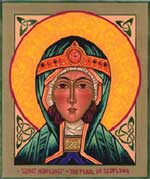St Margaret
 It could be argued that St Margaret was Scotland’s greatest female character. Born into a time where Scotland was a lawless and dangerous place St Margaret was a great civilising influence on the country and her legacy exists all over Scotland today.
It could be argued that St Margaret was Scotland’s greatest female character. Born into a time where Scotland was a lawless and dangerous place St Margaret was a great civilising influence on the country and her legacy exists all over Scotland today.
Margaret was born, possibly in Hungary, in 1046. A member of an ancient English royal family, she was a direct descendant of King Alfred and was the granddaughter of King Edmund Ironside of England through his son Edward. The families claim to the English throne was usurped when The English nobility elected Harold Godwin as Edward’s successor. Harold famously died at the Battle of Hastings when William the conqueror brought the Normans across from France.
Margaret’s mother Agatha realised that as Saxon royals the family was in great danger from the advancing Normans so decided to return to the Continent. However a storm drove their ship to Scotland, where Scottish King Malcolm III took the party under his protection, after much convincing (Margaret was already a profoundly devout religious woman) Malcolm Married her around 1069.
Queen Margaret’s influence on the Scottish court was immense, she brought European manners and culture which softened its barbaric reputation. Her greatest influence though was religious with many reforms, founded churches and monasteries including Dunfermline Abbey, put laws in place releasing workers from servile labour on the Sabbath and set up the ‘Queens Ferry’ over the forth so pilgrims could visit religious centres.
She also changed the language that mass was performed in from Gaelic to Latin. This aligned the church in Scotland closer to Rome but also may have been an attempt by Margaret to bring together England and Scotland and allow closer ties between the countries.
Margaret and Malcolm had eight children. Her time was given up to prayer and religious piety, however this may have led to her early death as constant fasting and abstinence weakened her (notwithstanding the eight children). In 1093 she fell gravely ill, only to learn that her husband and eldest son had been ambushed and killed at the Battle of Alnwick. She died shortly afterwards aged only forty-seven, her body was buried before the high altar at Dunfermline.
In 1250 Margaret was canonized by Pope Innocent IV, and her relics were moved to a new shrine in 1259. Unfortunately the lot of a saint is such that your earthly body though revered doesn’t get a lot of rest. During the Reformation her head passed to Mary Queen of Scots. It later was possessed by Jesuits but was lost during the French Revolution. Reputedly the rest of her relics, together with those of Malcolm, were acquired by Philip II of Spain but were also lost.
The feast of St. Margaret is now observed by the whole Church on 10 June. The Episcopal Church Commemorates St. Margaret each year on the Sunday closest to the anniversary of her death 16th November.





